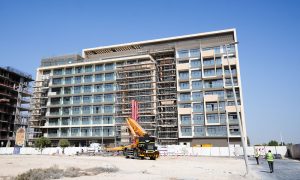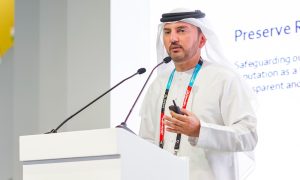On Site: The Walk JBR
Big Project ME takes a walk down JBR to find out what’s different about the redevelopment of one of Dubai’s most famous tourist landmarks.

RELATED ARTICLES: Dubai Properties appoints lead contractor for Dubai Wharf project | Shapoorji Pallonji wins contract for flagship tower in Al Khobar, KSA | Emaar, Dubai Holding launch development at Dubai Creek Harbour
Ever since it opened in 2008, The Walk at Jumeirah Beach Residences has been a popular destination for both tourists and residents of Dubai. With activities such as street painting, art displays and comedy shows alongside shops and restaurants, the city’s first outdoor retail avenue continues to attract millions of visitors every year.
Stretching a total distance of 1.7km, the shopping promenade overlooks the Arabian Gulf and houses as many as 305 retailers along its length. In addition, 11 luxury hotels – including international hospitality brands such as Hilton, Sheraton and Ritz-Carlton – have been established to cater to the estimated 12 million visitors a year.
Given those visitor figures, and the extensive work being done around The Walk, it’s no surprise that Dubai Properties Group, the project’s master developer, has launched an ambitious redevelopment scheme to completely revamp the look and feel of the retail avenue.
These developments include the introduction of new shaded areas to the many F&B and retail outlets along The Walk at street level, as well as an improved streetscape and access to the Plaza (or podium) level via escalators leading to new and enhanced retail facilities.
There will also be significant upgrades made to the Plaza level areas at Bahar and Rimal. Children’s play areas will be created, along with dedicated private areas for residents.
Furthermore, with the launch of the Dubai Tram in November, DPG says that part of the redevelopment work will include working with authorities to “further enhance traffic management and pedestrian flow in and around The Walk”. The intention is to create connectivity points for future planned stops for the Dubai Tram, the developer explains.
Although the redevelopment work itself is fairly straightforward, what does complicate matters is that shops and F&B outlets have remained open during the entire process. With thousands of visitors and hundreds of cars passing through the area daily, it’s easy to see how this could quickly devolve into a complicated situation.
“This project is not a normal construction project,” explains Sanjeev Nangia, project director for Shapoorji Pallonji Middle East, the contractor appointed to carry out the redevelopment of The Walk.
“It’s completely different. Our HSE measures on this project are maybe four times stronger than on any other project. This is a tourist area and there are many cameras. We don’t want any HSE issues here. That was the first instruction from the CEO of Dubai Properties Group. He didn’t want to see any complaints.
“Even if five people are working on site, we have a special HSE plan in place which covers how they’ll move around and where they’ll go. In every sector we have two engineers controlling [the site]. That’s not only the safety work, but also to take care of the movement of traffic. We have barricades and proper pathways for people to go through. There are about 40 flagmen altogether, who are continuously monitoring and guiding people.”
As the main contractor, Shapoorji Pallonji Middle East is tasked with working on three areas – The Walk itself; the Plaza (or Podium) level; and the Facades, the fronts of the retail and F&B outlets.
For the Walk itself, the contractor will be focusing on revamping the entire look of the ground level operations, giving it a “modern look” and increasing visibility, Nangia says. In addition, increased access will be given to the podium areas through the refurbishment and installation of escalators and lifts.
“The Walk area will also have these huge kiosks created to give visitors more space. They’ll be about eight metres tall. All the shops will have canopies and there will be escalators going up to the podium as well,” he explains. “For all of the stretch, the façade will be replaced. Earlier, it was some kind of paint, but now all of the 1.7km stretch will be given a rendered finish. So that means it will have a glittering effect that will shine at night. That’s the reason why we’re doing a complete repaint, re-plaster and re-render of the whole façade.
“There will also be an amphitheatre created in the Bahar section. The existing staircase there is in the Spanish style, i.e. a big sweeping staircase. That’s all going to be demolished and an amphitheatre, with a cantilevered steel structure roof, escalators and a green wall, will be built there.”
Nangia adds that the amphitheatre will be used for performances, while the escalator will lead to the podium level, which is also undergoing considerable rework. All of the existing parks and gardens on that level will be demolished, while existing retail outlets that aren’t doing well because of their location are likely to be converted into apartments.
“Out of the existing retail outlets, we’ll be creating 21 new apartments on the podium. Some of them will be double bedrooms, some will be single, and others will be studios.”
In addition, the contracting team will be redoing paving and lighting on both The Walk and the podium. The parapet on the podium was also removed, using a specialist demolition subcontractor, Reliable Star. The older, more traditional style of parapet is in the process of being replaced with glass railings for a modern look.
Scheduled to run from April 2014 to March 2015, the redevelopment of The Walk has posed a number of challenges to the Shapoorji Pallonji team. The first was assuaging the fears of owners, who were understandably reluctant to see their places of business become part of a giant construction site.
“There was a lot of complaints from shop owners and all, because obviously they didn’t want to close their shops, even for one day. But Dubai Properties Group had agreements with them about this renovation taking place. Even so, they wanted minimum disruptions,” Nangia relates.
“Before carrying out the work, we spent almost a month making a mock-up about how we’re going to work. We called in Dubai Properties, the consultants, everyone. The mock-up itself was planned and then redone until we came to a conclusion. We decided where the shop entrances were going to be while there was scaffolding up and people working on-site. Our main purpose with the mock-up was to minimise the disruptions and we managed to do that.”
The scaffolding that covers the entire site adds to an already congested area, with some 650 workers on-site at any given time. When the rest of the construction team is factored in, that number shoots up to close to 900 people working around the clock.
Nangia admits that starting work just prior to the summer midday break period did put a crimp in their plans for the site, especially since traffic in the area was already a major headache.
“Traffic is so much, and the rest area is [right down at the end of The Walk]. So at 12 o’clock, to bring them there – it takes about one hour. Once you leave the site, you have to go all the way around, due to the construction of the tram. It’s a big problem and it requires a lot of planning and HSE control, moving that amount of people,” he claims.
“Initially there were problems and we found that this wasn’t going to work, so now we’ve taken over huge podium areas which we’ve converted into rest areas, so there’s no need for them to come down and rest. We’ve got two or three areas now, otherwise it wouldn’t have been possible. The traffic and the travel time would have been too difficult and not in our hands.”
Operating on a 24-hour schedule, the project team runs from 6:30am to 5:30pm during the day, and from 6pm to 6am at night. This allows more work to be done and will allow the team to meet the scheduled completion date, Nangia promises.
The 24-hour cycle also allows crucial logistical work on site to be carried out, with the Shapoorji team liaising with the RTA to allow access to the site through the Marina. However, this also poses particular problems, due to the need to keep noise levels down in a heavily residential area.
“To manage the night shift, during the day time we make sure we do all the major activities that produce noise, while at night and during the early morning we do the things that don’t make that much noise, such as shifting materials, the rubbish removal and all that.
“We have permission from the RTA to get everything in here, the big trailers and so on, but that’s only during the early morning – after midnight up until 5am. All the major equipment comes in at night, but with winter coming, we’re afraid that people will be out till late at night, which could be a problem,” Nangia worries.
Traffic and ease of access aren’t the only problems hindering ongoing operations along the nearly two-kilometre project site. Not only is there ongoing construction work on other projects, which further creates congestion in the area, but there are also pre-existing utilities that hinder how Shapoorji Pallonji go about their business.
“Apart from these challenges, the other interesting thing was dealing with the authorities. There is a high-voltage cable corridor [running five metres from The Walk] and DEWA will not allow anyone to even plant machinery over there. That was a huge challenge, but it wasn’t just DEWA, there are Du cables as well as Etisalat cables. More interestingly, the Dubai Police have about 20 live cameras that are controlled by them. So we have had to relocate them off the parapet and then refit them over the glass replacement, without losing more than one or two days,” Nangia says.
Ultimately, the success of this project has come down to careful and decisive planning, Nangia says, pointing out that three planners are employed on the project, in contrast to the standard one or two, even on bigger projects.
“But if you don’t plan, then anything can go wrong,” he says, neatly summing up the philosophy behind this complex project.

























